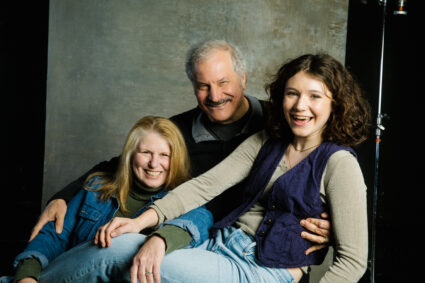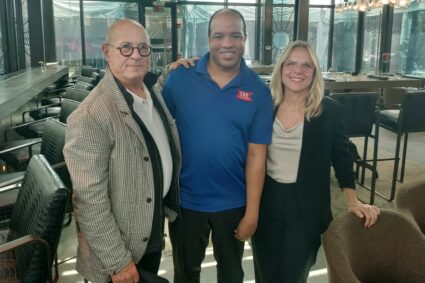
(©Stephen Sonnerstein – Photo courtesy of Magnolia Pictures)
On this edition of THE INTERVUE, the life of the legendary singer/songwriter, activist & icon Joan Baez heads to the big screen in a powerful documentary, “Joan Baez: I Am a Noise” coming this week to select theatres from Magnolia Pictures!
Neither a conventional biopic nor a traditional concert film, JOAN BAEZ I AM A NOISE is a raw and intimate portrait of the legendary folk singer and activist that shifts back and forth through time as it follows Joan on her final tour and delves into her extraordinary archive, including newly discovered home movies, diaries, artwork, therapy tapes, and audio recordings. Baez is remarkably revealing about her life on and off stage – from her lifelong emotional struggles to her civil rights work with MLK and a heartbreaking romance with a young Bob Dylan. A searingly honest look at a living legend, this film is a compelling and deeply personal exploration of an iconic artist who has never told the full truth of her life, as she experienced it, until now.
I recently sat down with co-directors Miri Navasky, Maeve O’Boyle, and Karen O’Connor to talk about following Joan on her final concert tour and finding the ultimate treasure trove to create this beautiful documentary that must be seen by all!
I must admit, this is one of the best documents, documentaries I have seen this year. Great job, very powerful performance, and very great narrative. The first question I want to ask is, when did your connection with Joan begin and what brought you three into the project?
Karen O’Connor (co-director): I met Joan back in 1986, I did a little PBS thing with her, we became friends. We’ve been friends for over 30 years now. Miri and I have made many films together. And then Maeve has worked with us on a couple of films, as well. Several years ago, Joan started talking about possibly doing a last tour. And so, we began to think there was something interesting potentially about finding a woman who had been famous for sixty plus years coming to the end of her music career. She wasn’t sure whether she would or wouldn’t quit but we thought either way, it could be kind of interesting.
We imagine that as a kind of verité, fly in the wall, following her on the last tour, and kind of thought about that for a while as a narrative anchor and then began filming. And midway through, Joan kept getting deeper and deeper involved in the film and decided to give us complete access to her personal and family archives. The scene in the film where she goes into the storage unit for the first time, that was the first time. She’d never been in there. She didn’t know what she had. And she turned it all over to us. So, for Miri, Maeve and I obviously you can understand as filmmakers that changed everything, it cracked open the film in a new way. And though we wanted to keep the final tour as a narrative anchor, it shifted how we imagined interweaving the past and the present.
Speaking along those lines, since we mentioned about Jon’s parents kept everything home movies, letters from the road and the like, so how did you take that sudden treasure trove of information and movies and others, and turned it into the documentary that we’re about to witness in the next few weeks?
Miri Navasky (co-director): It was one of my favorite parts of the filmmaking in this film, besides being with Joan, where we took each element. We took her journals and decided to make a kind of arc of each one. We took all the journals, transcribed what we wanted and bolted it all the way through her life. We took all her artwork, which started from five to, you know whatever it is, and put it in all these different periods. In an arc of her life, we took her audio tapes, transcribed all the family audio tapes, that her father had done and laid them in their own arc.
So, it was this constant. We went through her archival, like the formal interviews she had done on television, CBC & BBC and tried to pull them, transcribe them, and put them in chronological order. We first laid out the arc of every single letter, every single piece of archive we could. And we tried to figure out how are we going to add that into this contemporary story that we had, which was her final tour that we had filmed and followed her along. We were trying to get in all these different strands. So, we could go both backwards and forwards with her.
Maeve O’Boyle (co-director): I think that would go as an ambition to kind of find parallels between the stories, always in the in the present and in the past. And then, through that source archive, so that we could weave back and forth in a seamless way. And so that’s what we were always going for. It was an extraordinary piece of work to organize the archive. It took many months for us to do it, didn’t it? We took a long time to do it, but it was so worth it in the end, because you really had the whole thing laid out in this incredibly vast way. And you could find clues to the storytelling by weaving like that. So that was kind of the approach.
KOC: It did for us as we wanted it. This film to be immersive and really intimate in a surprising way. As you can tell, we didn’t have talking heads with other famous people talking about Joan, and it is in some way a family story. And so, the archive allowed us because we don’t have Joan’s family here other than the small moments we have with Pauline, who we got to interview before she passed away.
We got to use the archive to represent the family in the film in ways that also were hugely important and moving in the film. It was massive, it was really massive. We’ve never faced anything with a life like this musically, politically, personally. I’ve never, Miri nor Maven have ever come across one a family with that kind of archive. If somebody tried to do my story, they’d have about three photos. We couldn’t get over it.
MOB: I mean, it her life is huge. Her life is long and vast and complicated. And there’s so many layers to it. It is a huge undertaking. And it’s kind of how do you how do you tell a story like that; you know what I mean?
MN: We also knew we didn’t want to use other voices. And so, we do outside voices, we didn’t want to use the typical experts, we didn’t want to use famous people, that newer kind of, we kind of delve into the actual primary material of her life. And allow that to kind of tell her story.
MOB: As we knew that would give it a depth in a real layer of family personal kind of intimacy around that sort of stuff. So, it would get just give another layer to it.
Indeed, especially seeing the scenes where she was at the March on Washington 1963. which it’s sixty years ago. I’m glad you guys incorporate that. Now, the next question is for all three of you. During the documentary, what is one facet about Joan’s life that surprised you?
MN: I think it was hard. Karen knew Joan for a long time. She knew Joan’s life story quite well. Unlike Maeve and I, who I think had a little didn’t know her as well. And I knew I knew her music through my mom. I mean, I don’t know if this is a facet of her life in the past but dancing. Joan like her kind of aliveness and a love of dancing. In fact, the other day when we were talking, but it was kind of one person from her band said that it was her medicine.
She will break out spontaneously dancing all the time. And so, all those scenes of her dancing in the film are it was happening constantly. Wherever we were filming in a restaurant, out on the street, at the end of her concert on stage, off stage, you know, it, she use it to. I think to process herself or whatnot. So, it was something that I did not know that about her.
MOB: I also find that interesting when I met her first, she would just burst into spontaneous dance. But what I would also say is kind of like her creative energy, that incredible force that she is where she is always creating whether it’s music, art, or anything else. It’s that kind of inherent need to create, you know what I mean? I think that’s interesting, and a really interesting layer to her. I found that fascinating. I think she’s still like that now all the time. I really enjoyed that.
KOC: I knew about, as Joan described them, her inner demons. I think in some general way, seeing it laid out that from such an early age from five years old on really dealing then with what she called her panic attacks and anxiety issues. Seeing that psychiatric report from when she was 15 years old, I found it moving in a way. I’d heard some of it, but there was something to see this lifelong struggle to kind of come to the other side of these lifelong issues. It didn’t surprise me per se but there was something about seeing it all lined up with the kind of narrative arc in the film that I found really moving.
MN: Just to add on to that I’ll say because I found it in other ways to her political beliefs started when she was young. Her quakerism and in the same way that her anxiety followed her through her empathy for others and those that were suffering and pain and the underprivileged. I think it’s it started young. It was a true build into who she is. In a way that I think is unusual.
KOC: And then for me to see her on camera, and not surprising, but again, so moved even by the recollections and being with Dr. King at the March on Washington, where she, even the thought of it or the bravery of those young, African American kids who she said it wasn’t about me, I can’t imagine their courage, just the feeling of that still all those years later. And the kind of moral courage of that time, particularly now when we’re in such a weird, sort of global state. So, for me lots of emotion around that too, I would say.
My final question is this, which one of Joan’s songs is your favorite?
KOC: I love “Diamonds and Rust. I think that’s an amazing song. I think I love in the film, the way we use “It Ain’t Me Babe” where you hear it with the young (Bob) Dylan at that beginning of that kind of romance. And then fast forward to all those years later, and you hear Joan sing it alone in the film with that kind of lower register. And that sixty plus years voice. I love that in the film, so.
MN: I know that I could pick one song. I loved hearing. I mean, I discovered her music in some ways over the course of the film, even though I grew up with my mom listening to it all the time. I loved hearing the old Joan’s voice and that high octave and then this kind of new voice at that 80 in this different octave in almost every song. I loved the transformation of that, and I loved watching her lean into her voice, which I think kind of happened over the years happened over time. But there were sometimes during these concerts where it just kind of took your breath away.
MOB: I love “Diamonds and Rust”. I just love the narrative of it. I think it’s got this incredible story. It’s beautifully written by Joan. I just think musically, it’s phenomenal. I love it in the film. I think it looks phenomenal in the film. She’s gorgeous and it’s right in the middle. And of course, it tells that whole trajectory of Dylan so it’s just a great moment.
“Joan Baez: I Am a Voice” in NY theaters this Friday October 6 and expanding to LA & Additional Markets on October 13, 2023





